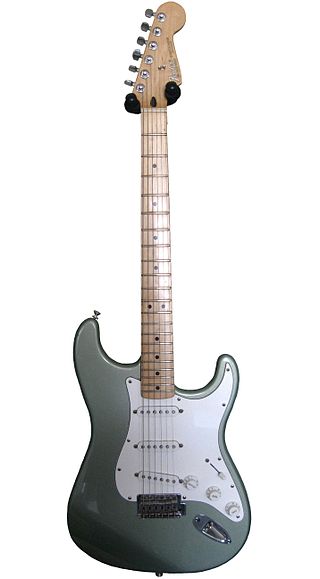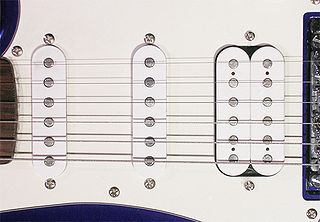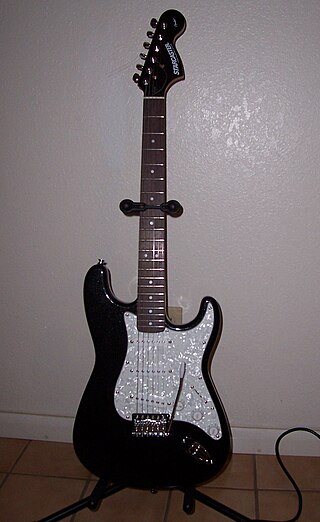
A humbucker, humbucking pickup, or double coil, is a guitar pickup that uses two wire coils to cancel out noisy interference from coil pickups. Humbucking coils are also used in dynamic microphones to cancel electromagnetic hum. Humbuckers are one of two main types of guitar pickups. The other is single coil.

The Fender Stratocaster, colloquially known as the Strat, is a model of electric guitar designed between 1952 and 1954 by Leo Fender, Bill Carson, George Fullerton, and Freddie Tavares. The Fender Musical Instruments Corporation has continuously manufactured the Stratocaster since 1954. It is a double-cutaway guitar, with an extended top "horn" shape for balance. Along with the Gibson Les Paul, Gibson SG, and Fender Telecaster, it is one of the most-often emulated electric guitar shapes. "Stratocaster" and "Strat" are trademark terms belonging to Fender. Guitars that duplicate the Stratocaster by other manufacturers are sometimes called S-Type or ST-type guitars.

A single coil pickup is a type of magnetic transducer, or pickup, for the electric guitar and the electric bass. It electromagnetically converts the vibration of the strings to an electric signal. Single coil pickups are one of the two most popular designs, along with dual-coil or "humbucking" pickups.
The Fender Jaguar is an electric guitar by Fender Musical Instruments characterized by an offset-waist body, a relatively unusual switching system with two separate circuits for lead and rhythm, and a short-scale 24" neck. Owing some roots to the Jazzmaster, it was introduced in 1962 as Fender's feature-laden top-of-the-line model, designed to lure players from Gibson. During its initial 13-year production run, the Jaguar did not sell as well as the less expensive Stratocaster and Telecaster, and achieved its most noticeable popularity in the surf music scene. After the Jaguar was taken out of production in 1975, vintage Jaguars became popular first with American punk rock players, and then more so during the alternative rock, shoegazing and indie rock movements of the 1980s and 1990s. Fender began making a version in Japan in the mid-1980s, and then introduced a USA-made reissue in 1999. Since then, Fender has made a variety of Jaguars in America, Mexico, Indonesia and China under both the Fender and Squier labels. Original vintage Jaguars sell for many times their original price.

The Fender Precision Bass is a model of electric bass guitar manufactured by Fender Musical Instruments Corporation. In its standard, post-1957 configuration, the Precision Bass is a solid body, four-stringed instrument usually equipped with a single split-coil humbucking pickup and a one-piece, 20-fret maple neck with rosewood or maple fingerboard.

A pickup is a transducer that captures or senses mechanical vibrations produced by musical instruments, particularly stringed instruments such as the electric guitar, and converts these to an electrical signal that is amplified using an instrument amplifier to produce musical sounds through a loudspeaker in a speaker enclosure. The signal from a pickup can also be recorded directly.

EMG, Inc. is the current legal name of a company based in Santa Rosa, California that manufactures guitar pickups and EQ accessories. Among guitar and bass accessories, the company sells active humbucker pickups, such as the EMG 81, the EMG 85, the EMG 60, and the EMG 89. They also produce passive pickups such as the EMG-HZ Series, which include SRO-OC1's and SC Sets. There is also a series geared towards a more traditional and passive sound known as the X series.

The Fender Telecaster Deluxe is a solid-body electric guitar originally produced from 1972 to 1981, and re-issued by Fender multiple times starting in 2004.
The Fender Lead Series was produced by the Fender/Rogers/Rhodes Division of CBS Musical Instruments. The series comprised Lead I, Lead II, Lead III and Lead Bass models.

The Squier '51 is an electric guitar made by Squier, a subsidiary of Fender. The '51 is notable for being one of the few original designs made by Squier, which normally manufactures less expensive authorized copies of Fender's popular guitars and bass guitars.

The Fender Wide Range Humbucker is a humbucker guitar pickup, designed by Seth Lover for Fender in the early 1970s. This pickup was intended to break Fender's image as a "single coil guitar company," and to gain a foothold in the humbucker guitar market dominated by Gibson.

Fender Telecaster Custom is a model of electric guitar made by Fender.

Fender Contemporary Stratocaster electric guitars were produced by Fender Japan in the 1980s.

The Fender HM Strat was an electric guitar produced by Fender Musical Instruments from 1988 until 1992. A relatively radical departure from Leo Fender's classic Stratocaster design, it was Fender's answer to Superstrats produced by manufacturers such as Jackson Guitars and Ibanez. The HM in the guitars name stands for heavy metal.
The Fender Bullet was an electric guitar originally designed by John Page and manufactured and marketed by the Fender Musical Instruments Corporation. It was first introduced as a line of "student" guitars to replace the outgoing Mustang and Musicmaster models.
Fender California Series electric guitars were produced by Fender in 1997 and 1998. The guitars were carved in California, shipped to Baja California Norte, Ensenada, Mexico for painting, then assembled in California.

The Fender Noiseless series is a line of electric guitar pickups made by the Fender Musical Instruments Corporation designed to cancel 60 cycle (Hz) hum noise while retaining the characteristic sound of single coil pickups. Introduced in 1998, these pickups consist of a pair of single coils stacked one on top of the other, compacted so as to match the shape and width space as a traditional Fender single coil guitar pickup, while being only slightly taller. The upper coil is actually the sound source, while the lower coil is responsible for the mains hum attenuation. Alnico V magnetic bars span from one coil to the other, crossing a soft ferrous steel spacer plate that isolates them, without touching it. The spacer plate has mainly two functions: to isolate the lower coil from the vibrations of the string, making sure that the sound is picked up only from the upper one, and to increase the magnetic flux that passed through both coils, increasing the output of the pickup. This is to be contrasted with the original noise canceling pickup, the humbucker, which is a double-wide, horizontally adjacent pair of single coil pickups with opposing phase.
The Fender Prodigy is a discontinued model of electric guitar produced by Fender from 1991 to 1993. It is one of Fender's attempts to compete with the superstrat-style guitars produced by Ibanez, Jackson/Charvel, Carvin Corporation and Yamaha. Since the Prodigy series was discontinued after about two and half years of production without a clear reason, it is considered one of Fender's rare models because of its limited production. Fender also produced a Prodigy Bass based on the Precision Bass Plus Deluxe featuring a P/J pickup layout (P as in Fender Precision Bass and J as in Fender Jazz Bass), 2-band active circuitry and a "fine-tuner" Schaller Elite bridge assembly.

Starcaster by Fender is a range of instruments and accessories aimed at students and beginners, marketed by the Fender Musical Instruments Corporation from the early 2000s until at least 2011. As of April 2018, no products were being marketed under this brand.
The Fender Telecaster, colloquially known as the Tele, is an electric guitar produced by Fender. Together with its sister model the Esquire, it was the world's first mass-produced, commercially successful solid-body electric guitar. Its simple yet effective design and revolutionary sound broke ground and set trends in electric guitar manufacturing and popular music.















